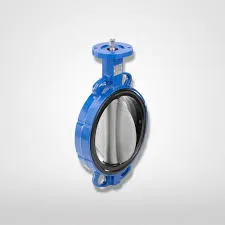نويابىر . 19, 2024 19:06 Back to list
resilient seated gate valve
Understanding the Resilient Seated Gate Valve A Crucial Component in Fluid Control Systems
In the world of fluid mechanics, the efficient control and regulation of fluid flow are paramount for various applications ranging from industrial processes to municipal water systems. Among the many types of valves available, the resilient seated gate valve stands out as a critical component, playing a vital role in ensuring systems operate smoothly, securely, and with minimal leakage.
What is a Resilient Seated Gate Valve?
A resilient seated gate valve is a type of valve that utilizes a gate mechanism to control fluid flow within a pipeline. The unique feature of this valve is its resilient seating material, usually made from rubber or a similar elastomer. This seating provides an excellent seal when the valve is closed, minimizing the risk of leakage—a crucial aspect in many applications where maintaining pressure and preventing contamination are essential.
The basic design consists of a gate, which moves up and down within the valve body to open or close the flow. When the gate is in the fully open position, the flow is unobstructed, allowing for maximum throughput. Conversely, when the valve is closed, the resilient seat compresses against the gate, creating a tight seal that prevents fluid from passing.
Advantages of Resilient Seated Gate Valves
1. Leakage Prevention One of the primary advantages of resilient seated gate valves is their ability to create a tight seal, thereby preventing leaks. This is particularly important in applications involving potable water, wastewater, or hazardous materials, where leakage can lead to contamination and environmental risks.
2. Ease of Operation Resilient seated gate valves typically require minimal torque to operate, making them easier to open and close compared to their metal-seated counterparts. This characteristic facilitates quick operation, which can be crucial in emergency situations.
resilient seated gate valve

3. Durability and Longevity The materials used in the manufacturing of resilient seats are designed to withstand harsh conditions, including temperature fluctuations and corrosion. This durability extends the service life of the valve, reducing the need for frequent replacements and, consequently, lowering maintenance costs.
4. Versatility Resilient seated gate valves can be used in a wide array of applications, including water supply systems, irrigation, fire protection systems, and industrial pipelines. Their adaptability makes them a go-to choice for engineers and facility managers alike.
5. Cost-Effectiveness Given their durability and low maintenance requirements, these valves often represent a cost-effective solution over their operational lifespan. While the initial purchase price may vary, the long-term savings in maintenance and replacement costs can be substantial.
Applications
The versatility of resilient seated gate valves allows them to be used in various settings. In municipal water distribution systems, they ensure that clean drinking water reaches communities without the risk of contamination. In wastewater treatment facilities, they help manage the flow of effluents safely and effectively.
In industrial applications, these valves are used in chemical processing, oil and gas operations, and power generation, where they control the flow of essential materials. Their robust design makes them suitable for high-pressure environments, further enhancing their functionality.
Conclusion
The resilient seated gate valve is a cornerstone of modern fluid control systems, offering a blend of reliability, efficiency, and cost-effectiveness. Its unique sealing capabilities, ease of operation, and versatility make it an indispensable tool in various industries. As infrastructure continues to evolve and the demand for efficient fluid management grows, the importance of resilient seated gate valves will undoubtedly increase. Their role in safeguarding our water systems, industrial processes, and environmental health remains crucial, ensuring that we can meet the challenges of today while planning for a sustainable tomorrow. Understanding the features and benefits of these valves is essential for anyone involved in fluid system design, maintenance, or management.
Share
-
Reliable Wafer Type Butterfly Valves for Every IndustryNewsJul.25,2025
-
Reliable Flow Control Begins with the Right Ball Check ValveNewsJul.25,2025
-
Precision Flow Control Starts with Quality ValvesNewsJul.25,2025
-
Industrial Flow Control ReliabilityNewsJul.25,2025
-
Engineered for Efficiency Gate Valves That Power Industrial PerformanceNewsJul.25,2025
-
Empowering Infrastructure Through Quality ManufacturingNewsJul.25,2025